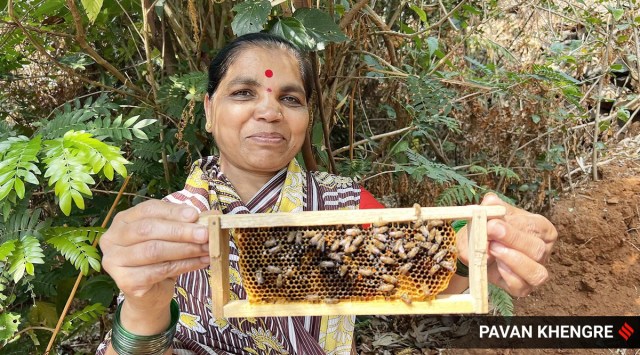The A, Bee, C of sweet prosperity
Manghar village, located about 10 km from Satara's Mahabaleshwar, was tagged as the 'country's first Honey Village' last May to promote beekeeping. Besides helping ecology, beekeeping has put this tiny village on the state tourism map and has also helped its residents earn a steady income.
 Shashikala Chorge, who earns about Rs 8,000 if the quantity of honey that month is good, holds a tray from the box she uses for beekeeping. (Express photo by Pavan Khengre)
Shashikala Chorge, who earns about Rs 8,000 if the quantity of honey that month is good, holds a tray from the box she uses for beekeeping. (Express photo by Pavan Khengre) The buzz of prosperity in Manghar village, located about 10 km from Satara’s Mahabaleshwar, has picked up pace since last May — a year after it was declared the ‘country’s first Honey Village’.
Surrounded by a dense forest of jamun trees, Manghar was awarded this honour by the state government through the Maharashtra State Khadi and Village Industries Board’s Directorate of Beekeeping Industry, which was established in Mahabaleshwar in 1946, to promote beekeeping. After Manghar village, the MSKVIB plans to promote beekeeping in more villages in Maharashtra as an alternative source of income that also helps maintain ecological balance.
Digvijay Patil, director, Directorate of Beekeeping Industry, said, “Beekeeping is essential for the ecology and we are taking all steps to promote it in rural areas. We chose Manghar village as our ‘first Honey Village’ due to its long-standing tradition of beekeeping and existing flora.”
Thanks to the May 2022 honour, over 1 lakh tourists have made a beeline for the village in the last one year. Suddenly turned into a tourist spot, the unexpected footfall and the resultant demand for refreshments helped the villagers pad their existing incomes. Stalls established by a committee of villagers constituted by the Directorate of Beekeeping Industry sold products worth Rs 3 lakh to these tourists.
In the hope of increasing this footfall, the village is now eyeing a spot on the state government’s tourist destination list and is also gearing up for the annual Tourism Village competition by the United Nations World Tourism Organisation (UNWTO), a “global initiative to highlight those villages where tourism preserves cultures and traditions, celebrates diversity, provides opportunities and safeguards biodiversity”.
 The Satara district administration has sanctioned a budget of Rs 50 lakh to develop basic infrastructure in the Manghar village, which lies on a hilly terrain. (Express Photo By Pavan Khengre)
The Satara district administration has sanctioned a budget of Rs 50 lakh to develop basic infrastructure in the Manghar village, which lies on a hilly terrain. (Express Photo By Pavan Khengre) Patil added, “The state government urged us to submit an application for the UNESCO contest. It is meant for villages in or near UNESCO heritage sites. The Kaas Plateau (Plateau of Flowers) and the Sahyadri Range are UNESCO heritage sites.”
Already a common practice long before May 2022, for 77-year-old Ganpat Parate, who has been involved in beekeeping since the 1970s, it was bees that helped him pay for the marriages of his four daughters. For 55-year-old Shashikala Chorge, the bees were a means to becoming financially independent.
Parate said all 100 houses in the village have now taken up beekeeping as an alternative source of income. Old-timers claimed the practice of keeping apiaries in the village started out of necessity — insufficient earnings from farming — in the late 1950s.
 Depending on the season and the environment, it takes the bees nearly four weeks to make a honeycomb. (Express photo by Pavan Khengre)
Depending on the season and the environment, it takes the bees nearly four weeks to make a honeycomb. (Express photo by Pavan Khengre) He said, “My family owns 0.23 acres but that is not enough to provide for the entire family. So we started collecting honey in the 1970s. It provided me with alternative income to the work I was doing,” Parate, who was Manghar’s Police Patil till 2013, a village official with quasi-judicial and administrative duties.
Parate added, “Now that my son is the Police Patil, I spend all my time collecting honey to support my family. I earn around Rs 5,000 per month from beekeeping and honey collection.”
The village, which has a population of just 466, is sprawled across 482 acres but has just 99 acres of agricultural land. The rest is forest land. However, the forest of jamun trees has proved to be a boon for its residents.
Mahadeo Jadhav, a 64-year-old village resident, said, “The villagers keep specially designed boxes to rear bees outside their houses and farms. However, most boxes — which have names of the owners on them — are kept in the forest. So most of the honey collected here is organic. Thanks to the jamun trees, the honey has the flavour of jamun in it.”
 Manghar resident Mahadeo Jadhav (left) and Narayan Jadhav, who leads the ‘Honey Village’ initiative on behalf of MSKVIB in the village, show the honeycombs on trays kept inside boxes in the forest around the village. (Express photo by Pavan Khengre)
Manghar resident Mahadeo Jadhav (left) and Narayan Jadhav, who leads the ‘Honey Village’ initiative on behalf of MSKVIB in the village, show the honeycombs on trays kept inside boxes in the forest around the village. (Express photo by Pavan Khengre) Villagers either purchase wooden boxes from Kolhapur or the MSKVIB provides it to them on subsidy. Each box contains a minimum of five trays and a maximum of ten. The bees too come from MSKVIB. Depending on the season and the environment, it takes the bees nearly four weeks to make a honeycomb. The quantity of honey extracted from a honeycomb too varies according to the environment and season. The yield is usually the highest during the flowering season.
Patil added, “Manghar was collecting 2,200 kg of honey every year, which has now increased to 3,000 kg. Efforts are on to establish it as a tourist destination. The Satara district administration is working towards providing all possible infrastructure to achieve this purpose.”
The district administration has sanctioned a budget of Rs 50 lakh to develop basic infrastructure in the village, which lies on a hilly terrain. The proposed infrastructure includes a motorable road to the village, signboards to help guide tourists through the dense jungle around Manghar, display boards, drinking water, sitting spaces and facilities for refreshments. At present, the village has an exhibition-cum-meeting hall and a separate room for displaying and selling the product.
 The Maharashtra State Khadi and Village Industries Board’s Directorate of Beekeeping Industry has provided a machine to process the honey and label the jars. (Express photo by Pavan Khengre)
The Maharashtra State Khadi and Village Industries Board’s Directorate of Beekeeping Industry has provided a machine to process the honey and label the jars. (Express photo by Pavan Khengre) “We show tourists a documentary on beekeeping and honey collection. We have also put on display various equipment such as the boxes used to keep bees, trays, machines used to extract honey and those used for packaging. Tourists are also given a live demonstration of the process,” said 64-year-old Narayan Jadhav, who leads the ‘Honey Village’ initiative on behalf of MSKVIB. Jadhav was elected unanimously by the villagers due to his experience with beekeeping.
A committee of villagers, the Madha Che Gaon Manghar Samiti, was constituted by the Directorate of Beekeeping Industry last year to coordinate honey collection and product sales, besides promoting the village as a tourist destination. Earlier, the villagers sold honey to a cooperative organization of beekeepers. The villagers now deposit their honeycombs to the samiti. The committee pays the locals depending on the quantity of honey and shifts the bees to new boxes, where they make a new honeycomb and more honey. The honey is sold under the brand name of Madha Che Gaon Manghar.
 The honey is now sold under the brand name of Madha Che Gaon Manghar. A 250 gram jar of unadulterated jamun-flavoured honey costs Rs 245. (Express photo by Pavan Khengre)
The honey is now sold under the brand name of Madha Che Gaon Manghar. A 250 gram jar of unadulterated jamun-flavoured honey costs Rs 245. (Express photo by Pavan Khengre) The samiti also handles the packaging and labelling of the bottles. The MSKVIB has provided support in the form of a machine to process the honey and label jars. The samiti filters the honey and packs it in bottles of different sizes. A 250 gram jar of unadulterated jamun-flavoured honey costs Rs 245. Besides stalls in the village, the honey is also available at MSKVIB outlets in Mahabaleshwar and Pune. In case of demand for online sales or export, the samiti said it would be happy to take the plunge.
Patil said organic honey collected from forest areas fetches Rs 500 per kg, while honey from around farm lands, which use pesticides, gets Rs 350 per kg. The quality of the honey is checked at a laboratory run by a beekeeping cooperative in Mahabaleshwar. The samiti hopes to procure kits for quality checks once the small laboratory that is being planned for the village is operational.
Anshu Sinha, who heads the MSKVIB, has urged the Directorate of Beekeeping Industry to encourage breeding of bees in the state.
Patil said a movement to ‘Save the Bees’ will be launched in the state since the population of bees is declining everywhere, including Maharashtra, due to urbanization, and the destruction of forests and green cover.
 Manghar village, which has a population of just 466, is sprawled across 482 acres but has just 99 acres of agricultural land. The rest is forest land. The village is surrounded by a dense forest of jamun trees that has proved to be a boon for its beekeepers. (Express photo by Pavan Khengre)
Manghar village, which has a population of just 466, is sprawled across 482 acres but has just 99 acres of agricultural land. The rest is forest land. The village is surrounded by a dense forest of jamun trees that has proved to be a boon for its beekeepers. (Express photo by Pavan Khengre) He added, “Besides the need for awareness on the importance of bees for the ecology, beekeeping will be promoted as part of agriculture, since it increases agricultural yield due to pollination. It will also prevent forest fires as villagers will man forests and ensure there are no fires or destruction of forest. Currently, a bee breeding project is on in Bhudargad in Kolhapur district, which has a history of beekeeping.”
Looking at the prosperity in Manghar, Jadhav said adjoining villages have started taking a keen interest in beekeeping.
For women of Manghar who are interested in joining the movement, the MSKVIB has provided them with training and kits. They are given training in making honey chocolates, honey cubes, honey candy and honey juice (honey mixed in lemon juice). The MSKVIB also plans to train the villagers in making candles from wax collected from honeycombs.
Locals said most youngsters from the village have shifted to urban areas, mainly Pune and Mumbai for employment. Since these youngsters live on fixed incomes, beekeeping has helped the parents reduce their financial burdens.
Chorge said, “My husband is a state government employee who works in Mahabaleshwar. I had a lot of time on my hands, so I turned to beekeeping and honey collecting. I have 20 boxes to collect honey now.”
Stating that she earns about Rs 8,000 per month if the quantity of honey is good, she added, “Like me, many other women are coming forward to learn about this process. Like me, the bees have helped them become financially independent.”



































